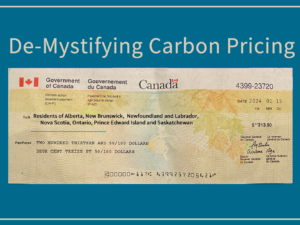
PDF: CCL Canada Carbon Pricing Policy Guidelines 05-26-16 When the new federal government came to power last October, they retained the former government’s inadequate greenhouse gas (GHG) emissions target [1] [2] with the promise that the Prime Minister and the Premiers would work out a pan-Canadian plan within 90 days of the Paris COP21. On March 3, the First Ministers issued the Vancouver Declaration on Clean Growth and Climate Change — which agreed to principles and a framework for a plan to meet or exceed the current emissions target.[3] Among other things, they agreed to using carbon pricing mechanisms to facilitate the transition to a low carbon economy. A working group is exploring options and will submit recommendations in September 2016. Implementation is scheduled to take place in early 2017. Canada, however, is a complicated federation. The provincial economies are all uniquely different: some are more resource-based while others are more geographically dispersed and some are much larger than others. Hence, assembling a comprehensive national carbon-pricing system will clearly be a challenge. The risk is that interprovincial negotiations over the costs and benefits of this climate action plan may be cited as the reason – or perhaps offered as an excuse – for intransigence and further inaction in reducing GHG emissions. Meanwhile, the threat posed by climate change becomes clearer with each passing season, and every year of delay increases the risk of hitting irreversible tipping points. It’s time for both Ottawa and the provinces to work together on an ambitious plan to significantly reduce our GHG emissions. This is an important shared responsibility. While details for a pan-Canadian climate plan are being worked out, CCL will be lobbying for fair and effective carbon pricing. Below are guidelines for what we consider acceptable: 1. Science-based targets must be enshrined into national law. 2. Any policy must include a national carbon price that is integrated across the country. It must be significant enough to drive changes in behaviour. We recommend this price be $30/tonne of CO2 equivalent by 2018,4 the price that is currently in place for BC and will be introduced in Alberta in 2018. For provinces with a lower carbon price or no carbon price, a federal carbon tax must be implemented. 3. To be effective at reducing emissions the carbon price needs to rise substantially every year. A steadily rising price provides a predictable market signal to drive innovation so that we meet or exceed our emissions target. We recommend a rate of increase of at least $10/tonne per year.[4] 4. The price should cover the entire economy and all GHG emissions, including upstream methane from oil and gas production. There should be no tax-exempt sectors. The best way to ensure this is to have the carbon price applied as far upstream as possible and at our borders where goods enter the Canadian economy. 5. A carbon pricing system needs to be fair for current and future generations. A fair carbon pricing system must ensure that costs and benefits are distributed equitably. A direct dividend to households would protect low and middle income households from higher costs, and would help build the support needed for a rising carbon price. 6. The carbon pricing system should be fully transparent and as simple as possible so that it cannot be “gamed” by special interests. The plan needs to be based on sound science and backed by quantitative analysis. It should include independent monitoring, evaluation and adjustment mechanisms. 7. Concerns about carbon pricing impacting international competitiveness can be addressed by the use of border adjustments for jurisdictions without a similar carbon price.[5] 8. Subsidies to the fossil fuel industry should be eliminated in order to focus on transitioning to a low-carbon economy. Examples of direct subsidies are capital cost allowances, tax relief, and government agencies that promote fossil fuel use and development. Federal and provincial direct subsidies are estimated to be $2.9 billion CAD for 2014.[6] 9. Any carbon pricing policy needs to be woven into a larger climate policy that includes broader regulations (e.g., building codes, fuel efficiency standards, land use policies), green infrastructure, incentives, financial mechanisms (e.g., green bank and green bonds), job re-training for workers in the fossil fuel sector, and education programs (e.g., how personal choices, including the food we eat, impact the climate). 10. Canada must provide global leadership on fighting climate change, including supporting the transition from fossil fuels in developing countries and helping those most vulnerable to adapt to changing conditions. FOOTNOTES: [1] Target is 30 percent below 2005 levels by 2030 http://www4.unfccc.int/submissions/INDC/Published%20Documents/Canada/1/INDC%20-%20Canada%20-%20English.pdf [2] https://cclca.wpengine.com/laser-talk-canadas-current-climate-targets-are-woefully-inadequate/ [3] https://news.gov.bc.ca/files/Vancouver_Declaration_clean_Growth_Climate_Change.pdf [4] Economic modelling by Navius Research shows that a price of $100/tonne by 2030 is not enough to meet the current target of 524 Mt CO2e in 2030, suggesting a larger carbon price is necessary, especially since the current target is inadequate for Canada’s fair-share contribution to the Paris agreement. See figure 7 in:http://ecofiscal.ca/wp-content/uploads/2016/04/Ecofiscal-Commission-Choose-Wisely-Carbon-Pricing-Revenue-Recycling-Report-April-2016.pdf The suggested price of $30 a tonne in 2018, rising by $10 a tonne per year, will reach $150 in 2030. [5] See https://cclca.wpengine.com/laser-talks/border-tax-adjustments/ [6] Touchette, Yanick & Whitley, Shelagh. G20 Subsidies to the Oil, Gas and Coal Industries, (2015). https://www.odi.org/publications/10091-G20-subsidies-oil-gas-coal-production-Canada Finalized, May 26, 2016 by the “Guard Rails Team”: Laurel Thompson (Montreal), Caterina Lindman (Waterloo), Frank Grossman (Willowdale), Keith McNeil (Clearwater), Sandy Aberdeen (Calgary), and Laura Sacks (Nelson) for drafting and finalizing the document and to Tom Cullen (Toronto), Cathy (Sudbury) and Gerry (Sudbury) for helping.CCL Canada’s Guidelines for our National Carbon Pricing Policy












